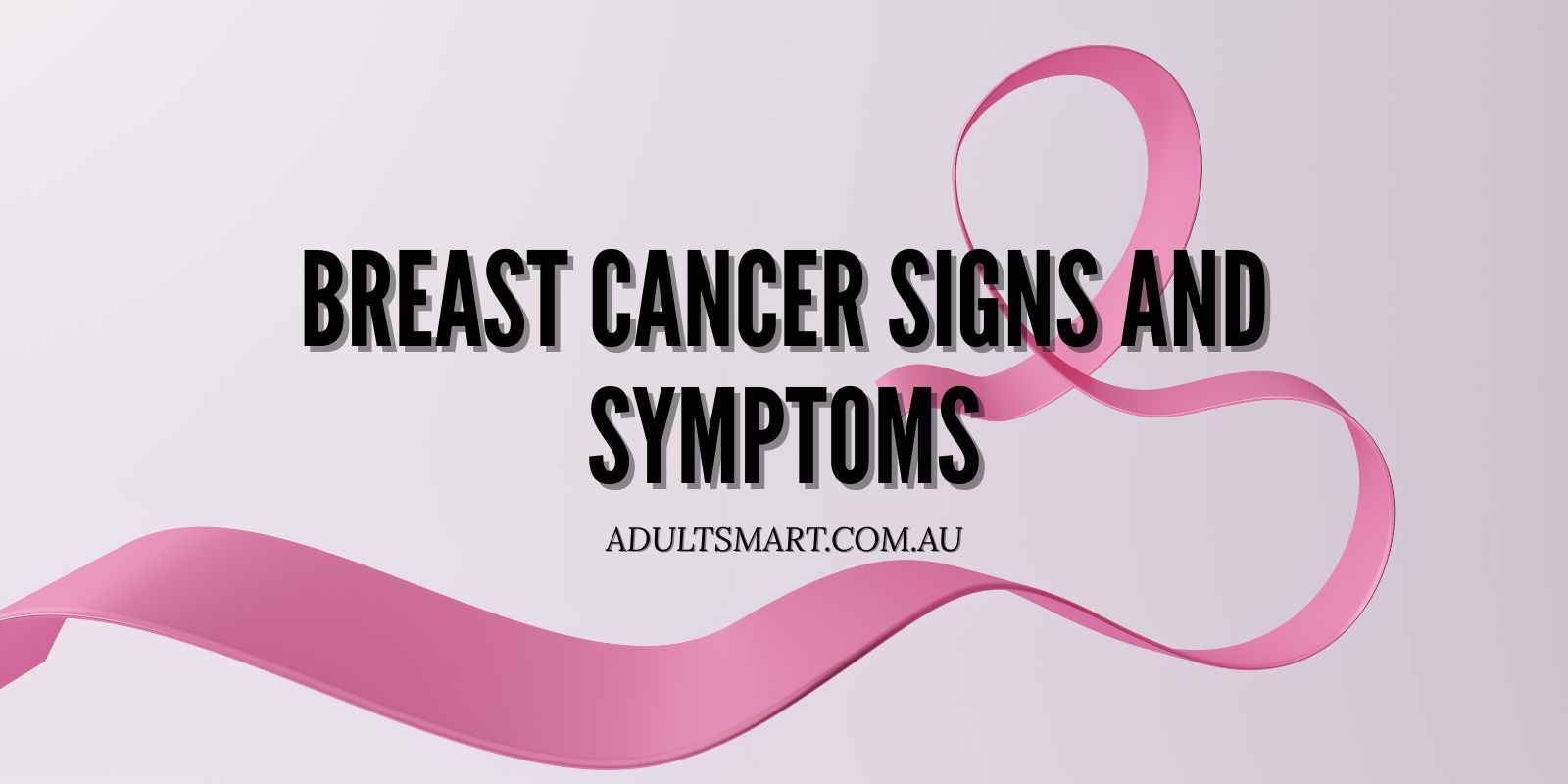Breast Cancer Signs and Symptoms: Early Detection Matters
Breast Cancer Signs and Symptoms can appear slowly, making awareness vital for early detection. Every person’s breast tissue changes over time due to hormones, weight, and age. Learning your normal shape and texture helps you notice when something feels different. A lump, skin change, or discharge may not always mean cancer, but it should never be ignored. Checking regularly builds confidence and reduces anxiety because you understand what is usual for your body.
This guide outlines key symptoms, common misconceptions, and when to see your doctor. It also explains how emotional and physical well-being play a part in staying proactive about your health. Reliable resources and real clinical experience help you separate fact from fear, empowering you to take charge of your breast health with calm and care.
Table of Contents – Breast Cancer Signs and Symptoms
- Understanding Breast Tissue Changes
- Common Breast Cancer Signs and Symptoms
- When to See a Doctor
- Emotional and Physical Impact
- Dr. Satish’s Insight on Awareness and Support
- Key Takeaways
- FAQ: Breast Cancer Questions
Understanding Breast Tissue Changes
Breast tissue changes naturally through life. Hormones, pregnancy, breastfeeding, perimenopause, and certain medicines can make the breasts feel tender, swollen, or slightly lumpy. These normal variations can shift every month, which is why knowing your regular pattern is essential. By doing a self-exam at the same time each month, you’ll recognize what’s typical and what feels new, firm, or fixed. Early detection starts with understanding your body, not fearing it.
The Cancer Council outlines clear steps for self-exams that include visual and tactile checks. Examine the entire breast, the nipple, the area under the armpit, and up toward the collarbone. Watch for dimpling, thickening, or redness that does not fade. Comparing both sides helps identify subtle differences. Breast Cancer Signs and Symptoms are easier to spot when you understand your baseline.
Knowledge about body awareness also supports calm observation. Physical arousal, temperature, or even posture can affect how the breast feels for a short time. Knowing how your body reacts helps you avoid false alarms. For more on how hormones influence sensitivity and circulation, read the Science of Female Orgasms. When a change lasts beyond one menstrual cycle or feels unusual for you, schedule a clinical review without delay.
Common Breast Cancer Signs and Symptoms
Recognizing Breast Cancer Signs and Symptoms early gives the best chance for effective treatment. Some changes appear quickly, while others develop slowly. The most common sign is a new lump or thickened area that feels different from the surrounding tissue. Lumps are often painless but may feel firm, fixed, or irregular in shape. Pain is less common, but if it persists, it deserves review. Swelling in part or all of the breast, even without a lump, can also be an early sign.
Other symptoms include changes in the nipple or skin. Look for nipple inversion, discharge that is not breast milk, or crusting around the nipple. The skin may pucker, dimple, or show redness that does not fade. Some people notice itching or a change in texture that feels like orange peel. These symptoms can come from harmless conditions, but they should still be checked. The Mayo Clinic lists these warning signs clearly and encourages prompt evaluation for anything unusual or persistent.
Keep a brief record of any changes—date, side, size, and texture—to share with your doctor. This helps show how long a symptom has been present. It can also prevent confusion if sensations shift due to your menstrual cycle or medication. Remember that many breast changes are benign, but only a clinical exam or imaging can confirm the cause. Trust your instincts, and if something feels new or different, get it checked without delay.
When to See a Doctor
Knowing when to see a doctor is an important part of understanding Breast Cancer Signs and Symptoms. Most breast changes are harmless, but any new lump, swelling, or skin change that lasts longer than one menstrual cycle deserves attention. If one breast feels noticeably different from the other, or if you experience pain, discharge, or nipple changes that persist, it’s time to schedule a visit. Even if the symptom turns out to be benign, reassurance from a clinical check reduces anxiety and prevents delay in treatment if needed.
Hormone shifts during perimenopause or menopause can cause temporary tenderness or fullness. These changes are usually symmetrical and come with other symptoms like hot flashes or vaginal dryness. Our article on Vaginal Dryness explains how reduced estrogen affects breast tissue, skin texture, and comfort. Noticing the difference between normal hormonal patterns and concerning changes helps you decide when to seek professional advice.
Book an appointment promptly if you notice: a new lump, visible distortion, skin puckering, or fluid from the nipple that appears without squeezing. During the visit, your doctor may perform a physical exam, imaging, or a simple needle test. Keep notes on what you’ve observed and share them clearly. Medical professionals appreciate precise details—it helps them choose the best next step. Regular screening, alongside awareness, remains the most effective way to detect breast cancer early and improve outcomes.
Emotional and Physical Impact
Breast Cancer Signs and Symptoms affect more than physical health—they can stir strong emotions. The fear of finding a lump, waiting for test results, or facing possible diagnosis can bring anxiety, sleeplessness, and changes in self-image. It’s normal to feel uncertain or overwhelmed. Reaching out for support early—whether to friends, family, or a counselor—can make the process easier to manage. Sharing your concerns with your doctor helps too; they can explain what to expect and guide you through each step with clarity and care.
The physical side effects of breast changes and treatment can also influence intimacy and sexual comfort. Tenderness, scars, or altered sensation may affect how you view your body. Emotional closeness and open conversation with a partner are important in maintaining trust and connection. The Sex and Menopause article explores how shifts in hormones and body confidence impact sexual health and recovery. These insights can help patients and partners rebuild closeness after treatment or during monitoring.
Taking care of your emotional well-being supports your physical healing. Simple steps like mindfulness, light exercise, and maintaining social ties can boost resilience. Support groups—both online and local—offer safe spaces to discuss feelings and experiences with others who understand. The goal is not to remove fear entirely, but to manage it with accurate knowledge and compassion. Recognizing Breast Cancer Signs and Symptoms early is powerful, but so is caring for the whole person behind them.
Dr. Satish’s Insight on Awareness and Support
In my years of clinical practice and research, I’ve seen how early recognition of Breast Cancer Signs and Symptoms saves lives. But awareness is more than knowing what to look for—it’s about creating habits of observation and care. Many people delay checks because they fear bad news. What I’ve learned is that knowledge reduces fear, not increases it. The earlier a concern is raised, the simpler the treatment options often become, and the higher the chance of a full recovery.
Awareness also includes self-compassion. Too often, patients blame themselves for not finding a change sooner. The truth is that breast tissue varies, and not all symptoms are easy to spot. Building a calm routine of monthly self-checks, even if brief, keeps the process natural and less stressful. Support from healthcare professionals, family, and community networks can make that commitment easier to maintain. Education and empathy work hand in hand—they turn fear into proactive health management.
I encourage every reader to see self-examination not as a medical task, but as an act of respect toward your own body. Taking a few minutes each month builds familiarity, confidence, and trust in your instincts. When you know your body well, any change stands out quickly. That awareness empowers you to act early and engage with your healthcare team without hesitation. Prevention starts with presence, and presence begins with self-awareness.

Key Takeaways
- Breast Cancer Signs and Symptoms can be subtle—early detection greatly improves treatment success.
- Check your breasts and armpits monthly for lumps, dimpling, or nipple discharge that feels unusual.
- Hormonal changes can cause tenderness, but persistent symptoms need medical review.
- Keep notes on any changes and share them with your doctor during check-ups.
- Awareness, emotional support, and routine screening together protect long-term breast health.
FAQ: Breast Cancer Questions – Breast Cancer Signs and Symptoms
How often should I check my breasts?
Once a month is ideal. Choose the same time in your cycle when breasts feel least tender, usually a few days after your period ends.
Are all breast lumps cancerous?
No. Most lumps are benign cysts or hormonal tissue changes. However, every new lump should be checked by a doctor to confirm the cause.
Can men get breast cancer too?
Yes, though it’s rare. Men have small amounts of breast tissue and should also see a doctor if they notice a lump, nipple change, or discharge.
Do breast changes always mean something serious?
Not always. Many changes come from hormones or medication. If something feels new or unusual, seek medical advice to stay safe.
What’s the best way to reduce my risk?
Maintain a balanced diet, exercise often, limit alcohol, and follow screening advice for your age and family history. Early awareness saves lives.

Welcome Dr. Satish Bendigiri adultsmart expert! With a rich academic and corporate background, he passionately explores love, marriage, and growth in his articles.








Leave a Reply